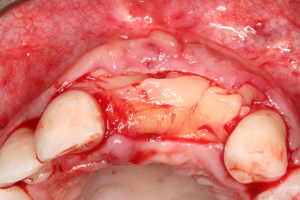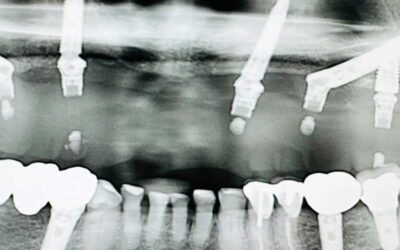How to Avoid/Prevent Dry Sockets
From baby teeth to wisdom teeth, the evolution of our teeth marks the journey from being an infant to becoming an adult. And while tooth loss is a normal part of childhood, adult tooth loss in Los Angeles is usually caused by decay, injury, and/or impacted wisdom teeth.
If you lose a tooth, the body naturally forms a blood clot in the empty tooth socket in order to protect the exposed jawbone, tissue, and nerves and to promote healing. However, if the blood clot doesn’t properly form or becomes dislodged from the socket as a result of failing to follow aftercare instructions, smoking cigarettes, or taking anticoagulant medications in Los Angeles, it can cause a painful condition called dry socket.
For expert care and treatment to prevent dry socket, contact CENTER for Advanced Periodontal & Implant Therapy in Los Angeles today!
What is Dry Socket?
Dry socket is a rare condition that can occur after a tooth extraction where there is inflammation of the jawbone (or alveolar bone). Also known as “alveolar osteitis,” the condition is relatively rare, occurring in only about 2% of tooth extractions, with the most commonly occurring after a wisdom tooth extraction.
3 Tips to Prevent Dry Socket after a Tooth Extraction
While it’s not possible to always predict who will get alveolar osteitis, some people are at greater risks for developing it, including:
- People with poor oral hygiene habits
- Prior history of dry socket after a tooth extraction
- Wisdom tooth extraction
- Taking birth control pills
Three helpful steps for avoiding painful complications after tooth loss:
1. Follow through with After Care
Your oral surgeon will provide you with mouthwashes and gels designed to help the socket heal properly, which will help prevent dry socket. Make sure to follow these aftercare instructions appropriately.
2. Discuss Your Current Medications with Your Periodontist
Certain prescription and over-the-counter medications can inhibit blood clotting, which can prevent the protective scab from forming over your empty sockets. Disclose all medications with your doctor prior to your tooth extraction
3. Stop Smoking a Few Days Before and After the Extraction
All products that contain nicotine interfere with the healing process following a tooth extraction or surgical procedure. Consider using a nicotine patch or other substitute for a few days to decrease your risk of complications.
Dr. Aalam and Dr. Krivitsky are board-certified periodontists with extensive experience working with patients to prevent dry socket as much as possible. For expert periodontal care, schedule an appointment with The CENTER for Advanced Periodontal & Implant Therapy in Los Angeles.
What Causes Alveolar Osteitis?
Dry socket can be caused by bacterial, chemical, mechanical, and physiologic factors. Here are some of the most common causes:
- Bacterial: A preexisting infection related to periodontal disease can prevent the proper formation of a blood clot. In addition, oral bacteria can cause the breakdown of the clot as well.
- Chemical: Smoking significantly increases the risk of developing dry socket. Nicotine causes a decrease in blood circulation and, as a result, the blood clot may fail to form after a tooth extraction.
- Mechanical: Specific activities like using a straw, spitting or smoking can dislodge the necessary blood clot.
- Physiological: Hormone fluctuations, a dense jawbone or poor blood circulation can increase the risk of developing this painful condition.
What are the Most Common Symptoms and Signs?
The first sign of alveolar osteitis may be the partial or total loss of a blood clot in the tooth socket. The jawbone may sometimes be visible and the surrounding tissue may appear gray due to poor circulation and lack of healing.
The symptoms of alveolar osteitis may include a throbbing pain shortly after a tooth extraction. The pain may radiate to other parts of the head such as the ears and the eyes. This pain may be accompanied by bad breath or a bad taste due to an accumulation of food debris and bacteria. Consult with your Los Angeles periodontal surgeon if you notice these signs and symptoms.
The Best Periodontal Prevention for Alveolar Osteitis
The CENTER for Advanced Periodontal & Implant Therapy in Los Angeles is proud to offer advanced platelet-rich fibrin (PRF) as an effective dry socket preventative measure. You’re in good hands because Dr. Aalam is one of the first periodontists in the United States to train in this revolutionary technique and routinely performs the PRF treatment for his patients.
How Does Advanced Platelet-Rich Fibrin Work?
The innovative PRF technique uses the patient’s own blood to create a protective membrane applied directly to the extraction site. This membrane is made up of white blood cells and platelets, which helps promote tissue growth and accelerate the body’s own ability to heal. When applied after tooth extraction or other surgical procedures, the CENTER’s patients have enjoyed quicker recovery times with a significantly decreased risk.
Learn more about dry socket prevention at WebMD.com.
Schedule a Consultation in Beverly Hills Today!
If you think you are looking for dry socket prevention or need to schedule a tooth extraction, do not wait to schedule a thorough screening and consultation at the CENTER for Advanced Periodontal & Implant Therapy in Beverly Hills. Dr. Aalam and Dr. Krivitsky have extensive training and experience helping patients achieve stronger, healthier gums. Call (310) 826-8242 or contact us online today!
You May Also Like...
How Much Do Dental Implants Cost in Southern California? A Complete Guide
If you're considering dental implants in Southern California, you’re likely wondering: How much will they cost? Are...
Can Zygomatic and Pterygoid Implants Be Done in a Day? Breaking Down the Process
Losing bone in the upper jaw can feel overwhelming, especially if you've been told traditional implants aren’t an...
Are Dental Implants Noticeable?
If you've lost one or more teeth due to periodontal disease, trauma, or other dental issues, you might be considering...




